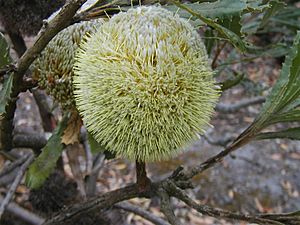Tennis ball banksia facts for kids
Quick facts for kids Tennis ball banksia |
|
|---|---|
 |
|
| Banksia laevigata subsp. laevigata in cultivation at The Banksia Farm | |
 |
|
| Subspecies fuscolutea | |
| Scientific classification | |
| Genus: |
Banksia
|
| Species: |
laevigata
|
| Synonyms | |
|
|
The Tennis Ball Banksia (scientific name: Banksia laevigata) is a special kind of shrub. It only grows in Western Australia, which means it's endemic there. This plant gets its common name because its flower heads look a bit like tennis balls! It has leaves with jagged edges and bright yellow or yellowish-green flowers. After the flowers, it grows seed pods called follicles, which have a slightly crinkly surface.
Contents
What the Tennis Ball Banksia Looks Like
The Tennis Ball Banksia is a shrub that usually grows between 1 m (3 ft 3 in) and 3.5 m (11 ft) tall. It has bark that looks rough and flaky, and it's grey in color. Unlike some other plants, it doesn't have a special underground stem called a lignotuber that helps it regrow after a fire.
Leaves and Flowers
Its leaves are long and narrow, or shaped like a wedge, with jagged edges. They are about 50–140 mm (2.0–5.5 in) long and 4–20 mm (0.16–0.79 in) wide. The leaves grow on a small stalk called a petiole, which is about 5–10 mm (0.20–0.39 in) long. When the leaves are young, they are a bit hairy, but as they get older, they become smooth (which is called glabrous).
The flowers grow in round heads, about 70–80 mm (2.8–3.1 in) wide. These flower heads usually appear at the ends of short side branches. The flowers themselves are yellow or yellowish-green. Each flower has a part called a perianth that is about 20–26 mm (0.79–1.02 in) long. It also has a curved pistil, which is the part that receives pollen, about 30–32 mm (1.2–1.3 in) long.
When it Flowers and Grows Seeds
The Tennis Ball Banksia usually flowers from September to December, or sometimes from January to February. After flowering, it produces seed pods called follicles. These follicles are long and oval-shaped, about 10–18 mm (0.39–0.71 in) long, 3–7 mm (0.12–0.28 in) high, and 4–7 mm (0.16–0.28 in) wide. Each flower head can have up to 100 follicles, which are surrounded by the dried remains of the flowers.
How it Got its Name
The Tennis Ball Banksia was first officially described in 1856 by a scientist named Carl Meissner. He wrote about it in a book called Prodromus Systematis Naturalis Regni Vegetabilis. The plant was found by another botanist, James Drummond, in a place called the Swan River Colony.
The second part of its scientific name, laevigata, is a Latin word. It means "smooth and polished," which might refer to the leaves becoming smooth as they age.
Two Types of Tennis Ball Banksia
In 1965, another scientist named Alex George found that there are actually two slightly different types, or subspecies, of the Tennis Ball Banksia. These two types are recognized by the Australian Plant Census:
- Banksia laevigata subsp. fuscolutea: This type has bright yellow flowers with a bit of a rusty color from tiny hairs.
- Banksia laevigata subsp. laevigata: This type has creamy-grey flowers with grey hairs.
Where the Tennis Ball Banksia Lives
The two subspecies of Tennis Ball Banksia grow in different areas of Western Australia.
Subspecies fuscolutea
The fuscolutea subspecies is found in a wider area. It grows in shrubland between Lake Barker, Hyden, and Mount Day, which is near Norseman.
Subspecies laevigata
The laevigata subspecies is found in a smaller area. It grows in the Ravensthorpe Range and along the Fitzgerald River. Here, it lives in both woodlands and shrublands.
Protecting the Tennis Ball Banksia
It's important to know if plants are safe or if they need our help to survive.
Status of Subspecies fuscolutea
The Western Australian Government's Department of Parks and Wildlife says that the fuscolutea subspecies is "not threatened." This means there are enough of these plants, and they are not currently in danger of disappearing.
Status of Subspecies laevigata
However, the laevigata subspecies is classified as "Priority Four" by the same department. This means it is rare or close to being threatened. Plants in this category need to be watched carefully to make sure their numbers don't drop too low.
Growing Tennis Ball Banksia at Home
If you want to grow a Tennis Ball Banksia from seeds, it's quite simple! The seeds don't need any special treatment before planting. Once planted, they usually take between 39 and 92 days to sprout.
Taylor, Anne; Hopper, Stephen (1988). The Banksia Atlas (Australian Flora and Fauna Series Number 8). Canberra: Australian Government Publishing Service. ISBN 0-644-07124-9.

